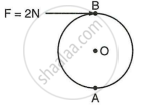Advertisements
Advertisements
प्रश्न
उत्तर
The turning effect produced by a force on a rigid body about a point, pivot or fulcrum is called the moment of force or torque. It is measured by the product of force and the perpendicular distance of the pivot from the line of action of force.
Examples of turning effect of force:
(i) Turning a steering wheel
(ii) Tightening a cap
APPEARS IN
संबंधित प्रश्न
State one way to decrease the moment of a given force about a given axis of rotation.
A potter turns his wheel by applying a force through the stick near the rim of wheel.
Find the moment of force of 20 N about an axis of rotation at distance 0.5 m from the force.
State the condition when the change in the momentum of a body depends only on the change in its velocity.
A, B and C are the three forces each of magnitude 4 N acting in the plane of the paper as shown in Figure. The point O lies in the same plane.

- Which force has the least moment about O? Give a reason.
- Which force has the greatest moment about O? Give a reason.
- Name the forces producing
(a) Clockwise
(b) anticlockwise moments. - What is the resultant torque about the point O?
A wheel of diameter 2 m is shown in the figure with the axle at O. A force F = 2 N is applied at B in the direction shown in the figure. Calculate the moment of force about
- the centre O, and
- the point A.

Define the moment of force.
Give an example for each of the following uses of a machine:
to change the point of application of force
State one factor on which the magnitude of a non-contact force depends. How does the magnitude of a non-contact force change along with distance?
Two similar vehicles are moving with the same velocity on the road, such that one of thus is loaded and the other one is empty which of the two vehicles will require larger force to stop?
